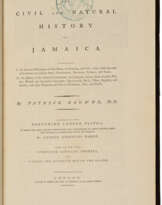ID 1032666
Lot 14 | The Civil and Natural History of Jamaica
Estimate value
$ 5 000 – 8 000
A fresh and excellent copy of the second edition of an important work of Caribbean botany, from the library of naturalist Thomas Forster and his dog Shargs. This second edition introduces a large map and a set of indices of Linnaean binomials; the plates were re-engraved, with captions added, after a fire destroyed the copperplates used to print the 1756 first edition. The author, Patrick Browne, was an Irish naturalist and physician who spent about a decade in Jamaica. He was the first Anglophone author to use Linnaeus's system of classifying plants in print, and his work is illustrated with plates after the great botanical artist Georg Ehret. Bibliographia Jamaicensis 416 (as the third edition, after a 1769 issue consisting of part 1 only and without plates); Sabin 8671; Stafleu and Cowan 842.
Folio (363 x 230mm). Half title. Engraved folding map of Jamaica by Thomas Kitchen printed on blue paper and 49 engraved plates after drawings by Georg Dionysius Ehret (very minor dustsoiling around edges of some plates, final indices lightly toned). Contemporary marbled calf gilt (neatly rebacked preserving original spine panel and endpapers). Provenance: Thomas Furley Forster, 1761-1825, English botanist (ownership inscription on title; by descent to his son:) – Thomas Forster, 1789-1860, British naturalist and animal rights activist, Julia Beaufoy, 1790-1870, his wife, and his dog, Shargs (signature dated 19 May 1841, as well as stamps of Julia and Shargs).
| Artist: | Patrick Browne (1720 - 1790) |
|---|
| Artist: | Patrick Browne (1720 - 1790) |
|---|
| Address of auction |
CHRISTIE'S 20 Rockefeller Plaza 10020 New York USA | ||||||||||||||
|---|---|---|---|---|---|---|---|---|---|---|---|---|---|---|---|
| Preview |
| ||||||||||||||
| Phone | +1 212 636 2000 | ||||||||||||||
| Fax | +1 212 636 4930 | ||||||||||||||
| Conditions of purchase | Conditions of purchase | ||||||||||||||
| Shipping |
Postal service Courier service pickup by yourself | ||||||||||||||
| Payment methods |
Wire Transfer | ||||||||||||||
| Business hours | Business hours
|






